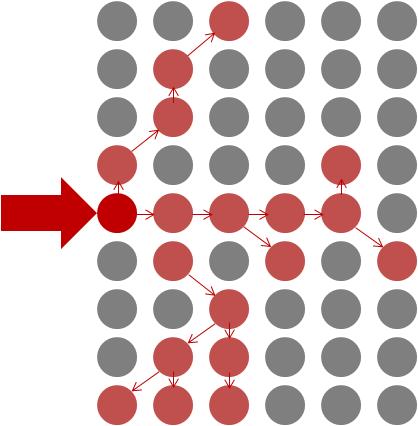The “Death of Marketing” Has Been Announced Prematurely
Aug 23, 2010 Industry News, Marketing And Advertising Analytics, Social Media, Web Analytics
Has there been a fundamental change in how people think about and buy goods and services? Is old-school marketing dead?
According to the recently-minted orthodoxy of social media, marketing is being transformed, and we are moving from the Age of Push to the Era of the Conversation. The Don Drapers of the world, they say, will now have to play the new way, find new jobs or become hobos. Participation in a conversation is voluntary, per the new theory, meaning marketers can’t unilaterally control conversations and so now must learn to communicate differently with the people in the marketplace.
WHAT HASN’T CHANGED
Marketing Has Always Been A Conversation – Marketers Just Haven’t Recognized It Until Now
There is an important truth here – much of the conversation about brands and products is intra-customer, and doesn’t involve the marketer at all. This has always been the case, but it just has not been as observable until it started happening online.
Audiences Have Always Been Able to Walk Away
Audiences have always asserted more control over the “conversation” than marketing models have admitted. People have been fast-forwarding and channel-surfing through television ads since they figured out which remote control buttons to use. Since the very birth of mass media, admen and their clients have been solving and re-solving the problem of how to entice an audience to listen to their stories instead of wandering off to grab something from the refrigerator.
Propaganda Still Works
Working against this is has always been the fact that (as psychological experiments have shown) repeated messages have an influence on peoples’ perceptions and behavior even if they are skeptical or not paying full attention, and even if they are aware they are being ‘sold’.
WHAT HAS CHANGED
The Emergence of Social Media
Thanks to social media lowering the bar for what constitutes a relationship, people are regularly engaging in communication with a wider circle of casual or low-involvement contacts.
Conversations are Observable and Trackable
We can find out what people are saying about brands and our products (at least when they happen in online social media). These conversations can assert a great deal of influence on buying behavior.
Advertisers and Marketers can Participate in the Conversation
Marketers can, when they decide it is to their advantage, participate in these conversations and assert some influence on the the agenda and the messages
Advertisers and Marketers can START the Conversation
Marketers can initiate conversations, and they can provide the platform or venue for these conversations to take place. However, the the attempt can backfire. Conversations can and will change locations if a community gets the sense that there is excessive censoring or propagandizing.
SO?
So, things have changed, but not that much. People still need to buy things, they still need to decide what to buy and where to buy it. It’s just that now, people increasingly use social media (among other channels) to get information about products and services they are considering. Social networks have always been influential, but now they are pervasive, instantaneous, and measureable. So you shouldn’t ignore social media, you should listen to and participate in it. That’s all.
Tags: Death of Marketing, Don Draper, Facebook, hobo, LinkedIn, listening, Listening programs, marketing, Marketing as Conversation, Social Media, Twitter
Listing Your Way to the Finish Line
Mar 25, 2010 Statistics, TV and iTV Analytics, Web Analytics
Draft Marketing Analysis Checklist
After reading Atul Gawande’s recent book “Checklist Manifesto”, I was thinking there should be a checklist for marketing analysis. One point that Mr. Gawande makes in his book is that highly-trained specialists shun checklists because in their minds only dummies need lists. However, a majority of surgeons, while rejecting lists for their own use, would want another surgeon to use one if operating on them. This is because they know how easy it is to forget one detail in hundreds.
In marketing analysis, there are a lot of steps and a lot of things to think about, and even a smart person might drop a stitch here or there if they are not following some kind of list. I have included a rough one I dashed off quickly, in hopes that others might offer refinements, altogether better lists, or more specific versions for types of marketing programs. Here it is, have at it!
DEFINE
• SET goals/ hypotheses for program
• SELECT metrics
• CREATE a measurement plan
EXECUTE
• EXECUTE program and measurement plan
• VALIDATE raw data
• PREPARE dataset for analysis
ANALYZE
• VISUALLY EXPLORE dataset for patterns and problems
• SUMMARIZE dataset statistics
• SCORE performance vs. goals/ support for hypotheses
• LIST likely conclusions
• IDENTIFY unexpected or surprising findings
• VALIDATE likely conclusions with numerical/statistical support
• SELECT final findings
COMMUNICATE
• REPORT findings for future activity
• REVIEW findings with user community
• CAPTURE questions &issues from user community
FOLLOW-UP
• INVESTIGATE user-identified questions & issues
• IDENTIFY impact on original findings
• REPORT findings of follow-up analysis
What do you think?
Tags: Analysis, Analytics, Atul Gawande, Check, Checklist, List, marketing, Process
The Cookie vs. The LSO – Should I Care? Should I Worry?
Feb 18, 2010 Industry News, Web Analytics
Here’s a question that savvy web users were being asked by their parents 10 years ago:
What the heck is a cookie, and why do I have them on my computer? Do I need to delete them? How do I delete them?
Don’t be surprised if the question starts to come up again, in a new form:
What the heck is an LSO, and why do I have them on my computer? Do I need to delete them? How do I delete them?
The issue is emerging again because of the people in the business of targeting ads or offers are trying to do their job better, and cookies are not doing the job advertisers want done. So, some web programmers are exploiting a feature of Flash to create “stealth cookies” called LSOs, in hopes that you won’t delete them because you probably don’t know how.
Remind me: What is a cookie again?
A cookie is a small text file that is created via your browser to keep track of session “state” and historic entries and site activity.
What is a cookie for?
The connectionless protocols used by the web do not automatically keep track of any history. If there is no state or history information provided with a page request, then the page will have no idea who you are, even if you just entered that info on a different page in the same site.
What’s so scary about that? Well, people just don’t like their activity being recorded without their permission or awareness. It annoys them. That said, there are useful things that this kind of snooping makes possible:
At the same time, it makes possible:
Cookie Deletion
When many people figured all this out it became a big kerfuffle, and this led to user behavior such that 23% of all cookies are deleted when they are one week old, and that less than half of all cookies (43%) live to be more than eight weeks old (click here to see Microsoft research about cookie deletion). Users can use functionality in their browsers to delete cookies and to control cookie-related policies within the browser.
So who cares? What problems does cookie deletion cause?
If you are an internet advertiser, it adds one more layer of complexity to the already difficult problem of tracking internet ad campaigns. You’ll have tracking pixels in ads to capture views and clicks, but knowing how many times someone has seen an ad during a campaign (frequency) and how many distinct individuals have seen an ad (reach) is pretty critical to understanding what is going on in a campaign, especially as more brand advertising comes online. Measurement is made difficult in internet advertising by these factors:
Net/Net: Bad Measurements
On balance, these issues push the measurements in the direction of overcounting reach and undercounting frequency.
Some of the other deficiencies of cookies from an advertiser point of view are that cookies don’t store very much information (4KB), and there can only be so many cookies related to a given domain (20). Privacy considerations additionally limit how much cross-site behavior can be captured in cookies (and banner campaigns are cross-site, mostly).
LSOs Addess Some of These Shortcomings For Advertisers (Yay!), But Create New Ones for Users (Boo!)
An LSO (Local Storage Object) is a cookie-like file that Flash uses to store information for Flash applications. Except that they are used by clever web programmers for far more than that – they are used by some sites just like really big cookies (as much as 25 times bigger than a cookie) that you don’t know about and so won’t delete. In addition, the same LSOs are accessible from all browsers. Your browser security controls have little or no impact on these things.
You Might Want To Check Your Computer For LSOs Right Now
If you don’t believe me, go to the Macromedia page that lets you see what LSOs are on your machine (it also lets you delete them, enable/disable them, and control their behavior).
It is located here: http://www.macromedia.com/support/documentation/en/flashplayer/help/settings_manager07.html.
While you are there, delete the ones for sites you don’t want your boss to know about.
As for where this is all going, all privacy loopholes on the web are temporary, and there are already browser add-ins that let you control and delete LSOs, and at some point the browsers will absorb that functionality to make it easy for you to use. If I were you, I’d worry more about the things you can’t see: The new keystroke dynamics technique for identifying users announced by Scout Analytics (here) and backend ISP- and CDN- based tracking – all these are fodder for more paranoid posts in the future.
Tags: Analytics, banners, Campaign Analytics, Cookies, Flash Cookies, frequency, Internet Advertising, LSOs, marketing, Media Measurement, Privacy, reach, Security


